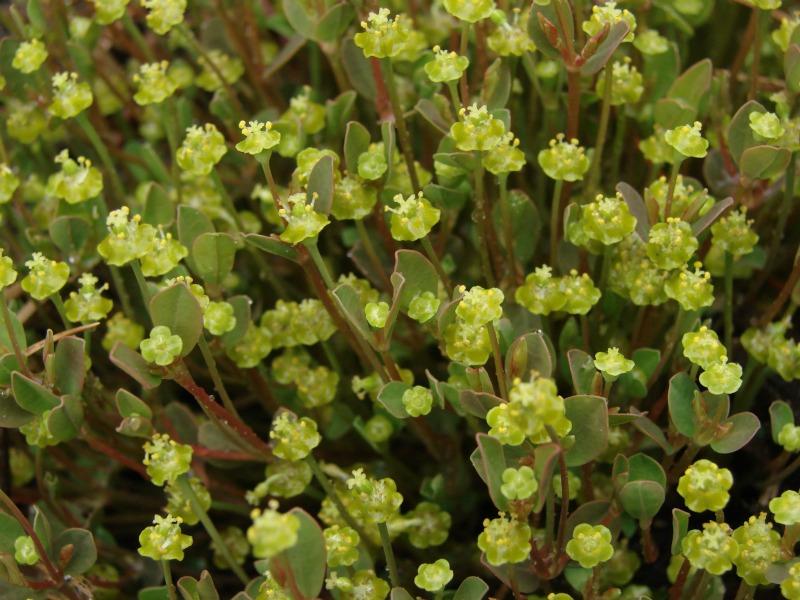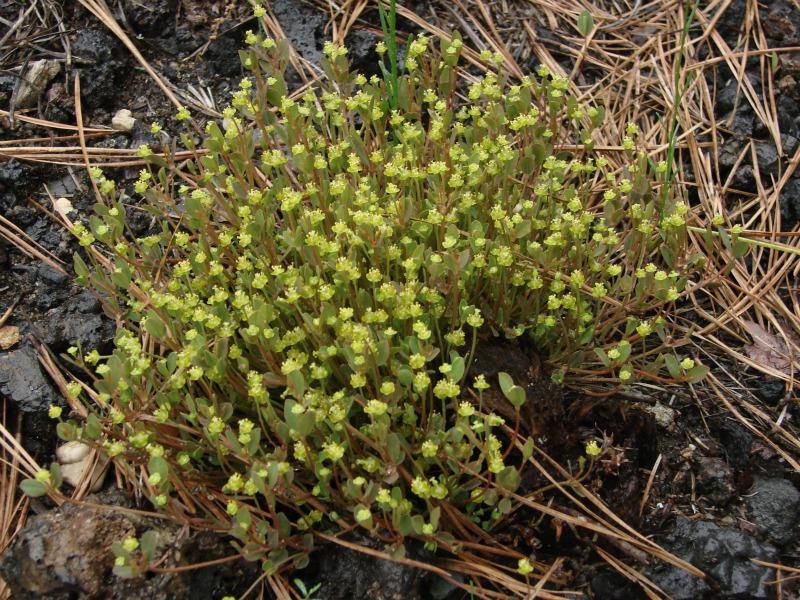Ipecac Spurge
Euphorbia ipecacuanhae L.
- Class
- Dicotyledoneae (Dicots)
- Family
- Euphorbiaceae (Spurge Family)
- State Protection
- Endangered
Listed as Endangered by New York State: in imminent danger of extirpation in New York. For animals, taking, importation, transportation, or possession is prohibited, except under license or permit. For plants, removal or damage without the consent of the landowner is prohibited.
- Federal Protection
- Not Listed
- State Conservation Status Rank
- S1
Critically Imperiled in New York - Especially vulnerable to disappearing from New York due to extreme rarity or other factors; typically 5 or fewer populations or locations in New York, very few individuals, very restricted range, very few remaining acres (or miles of stream), and/or very steep declines.
- Global Conservation Status Rank
- G5
Secure globally - Common in the world; widespread and abundant (but may be rare in some parts of its range).
Summary
Did you know?
This plant has been used to make an emetic (causes vomiting to clear the stomach) called Wild Ipecacuanha or syrup of ipecac. The original Ipecacuanha, (Psychotria ipecacuanha) of the family Rubiaceae, is a tropical, small, shrubby flowering plant, the root of which is most commonly used to make syrup of ipecac. It is native to Brazil and was known to Europeans by the mid-1600s. Its name comes from the Tupi language i-pe-kaa-guéne, translated as 'road-side sick-making plant' (Wikipedia contributors).
State Ranking Justification
There are 4 small existing populations and about 20 historical occurrences.
Short-term Trends
There is not enough recent information to determine short-term trends.
Long-term Trends
There seems to have been a substantial decline from historical records. Most existing populations are very small, so future trends may also be downward.
Conservation and Management
Threats
It is threatened by use of and succession of sandy areas, railroad embankments, and roadsides.
Conservation Strategies and Management Practices
This species needs disturbance to reduce competition from woody plants or more aggressive herbaceous plants, but too much direct disturbance to the plants will reduce the population. Its habitat could be disturbed in the non-growing season to open it up for seed germination and colonization, but direct disturbance should be prevented during the growing season.
Research Needs
Habitat preference needs to be studied for this species to determine why there are so few plants in an extensive habitat.
Habitat
Habitat
In New York State, American Ipecac has been found along railroad tracks, on pebbly roadsides, and in pitch pine barrens (New York Natural Heritage Program 2010). Dry lands, pinelands and barrens (Fernald 1970). In sand, chiefly on the coastal plain (Gleason & Cronquist 1991).
Associated Ecological Communities
- Mowed roadside/pathway*
A narrow strip of mowed vegetation along the side of a road, or a mowed pathway through taller vegetation (e.g., meadows, old fields, woodlands, forests), or along utility right-of-way corridors (e.g., power lines, telephone lines, gas pipelines). The vegetation in these mowed strips and paths may be dominated by grasses, sedges, and rushes; or it may be dominated by forbs, vines, and low shrubs that can tolerate infrequent mowing.
- Pitch pine-scrub oak barrens*
(guide)
A shrub-savanna community that occurs on well-drained, sandy soils that have developed on sand dunes, glacial till, and outwash plains.
- Railroad
A permanent road having a line of steel rails fixed to wood ties and laid on a gravel roadbed that provides a track for cars or equipment drawn by locomotives or propelled by self-contained motors. There may be sparse vegetation rooted in the gravel substrate. The railroad right of way may be maintained by mowing or herbicide spraying.
* probable association but not confirmed.
Associated Species
- Nuttallanthus canadensis (old-field-toad-flax)
- Pinus rigida (pitch pine)
Range
New York State Distribution
This small herb occurs in Nassau and Suffolk counties on Long Island and has been reported from Queens. It was historically known from Staten Island and is considered extirpated from Manhattan.
Global Distribution
This small herb grows on the Atlantic coastal plain from Connecticut and Long Island south to Florida. It is also disjunct in Indiana.
Identification Comments
General Description
American Ipecac is a perennial herb, with many spreading to ascending stems up to 30 cm tall, branching many times from a long thick underground root. The leaves are opposite, emerging from the joints, sessile, fleshy, varying in shape (even on the same plant) from linear to ovate or obovate, as well as color (from green to red or purplish), and up to 5 cm long. The flowers are terminal on long slender (1.3 to 4.5 cm) stalks, and have a fleshy involucre with 5 petal-like lobes the same color as the leaves and stems, bearing glands in the sinuses. The involucre surrounds and contrasts with the white and yellow stamens arranged around a single central pistil (Gleason and Cronquist 1991).
Best Life Stage for Proper Identification
A flowering stem with roots is needed for identification.
Similar Species
Euphorbia corollata and E. marilandica's involucres have glands with conspicuous white appendages much exceeding the gland and commonly as long as or longer than wide (E. ipecacuanhae's glands have inconspicuous short green appendages). E. mercurialina has white appendages on its glands and cilia on its leaves (Gleason and Cronquist 1991).
Best Time to See
American Ipecac flowers in May and the fruits develop in June and may persist into August.
- Flowering
- Fruiting
The time of year you would expect to find Ipecac Spurge flowering and fruiting in New York.
Ipecac Spurge Images
Taxonomy
Ipecac Spurge
Euphorbia ipecacuanhae L.
- Kingdom Plantae
- Phylum Anthophyta
- Class Dicotyledoneae
(Dicots)
- Order Euphorbiales
- Family Euphorbiaceae (Spurge Family)
- Order Euphorbiales
- Class Dicotyledoneae
(Dicots)
- Phylum Anthophyta
Additional Common Names
- American Ipecac
- Carolina Ipecac
- Wild Ipecac
Additional Resources
Best Identification Reference
Gleason, Henry A. and A. Cronquist. 1991. Manual of Vascular Plants of Northeastern United States and Adjacent Canada. The New York Botanical Garden, Bronx, New York. 910 pp.
Other References
Fernald, M.L. 1950. Gray's manual of botany. 8th edition. D. Van Nostrand, New York. 1632 pp.
Holmgren, Noel. 1998. The Illustrated Companion to Gleason and Cronquist's Manual. Illustrations of the Vascular Plants of Northeastern United States and Adjacent Canada. The New York Botanical Garden, Bronx, New York.
Mitchell, Richard S. 1986. A checklist of New York State plants. Bulletin No. 458. New York State Museum. 272 pp.
New York Natural Heritage Program. 2010. Biotics database. New York Natural Heritage Program. New York State Department of Environmental Conservation. Albany, NY.
New York Natural Heritage Program. 2024. New York Natural Heritage Program Databases. Albany, NY.
Weldy, T. and D. Werier. 2010. New York flora atlas. [S.M. Landry, K.N. Campbell, and L.D. Mabe (original application development), Florida Center for Community Design and Research http://www.fccdr.usf.edu/. University of South Florida http://www.usf.edu/]. New York Flora Association http://newyork.plantatlas.usf.edu/, Albany, New York
Links
About This Guide
Information for this guide was last updated on: February 23, 2011
Please cite this page as:
New York Natural Heritage Program. 2024.
Online Conservation Guide for
Euphorbia ipecacuanhae.
Available from: https://guides.nynhp.org/american-ipecac/.
Accessed July 27, 2024.


